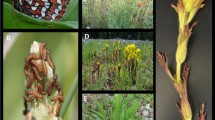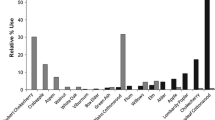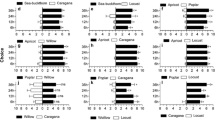Abstract
Investigations of host plant selection in herbivorous arthropods have emphasized the importance of oviposition site selection by adults; however, a more complete picture of this process requires additional consideration of the factors influencing host plant choice during the immature feeding stages. We conducted a series of larval choice experiments to examine both the innate and induced preferences of larvae of the Silver-spotted skipper (Epargyreus clarus L.) on three commonly used hosts (Wisteria, Robinia, and Pueraria). Late instar E. clarus larvae reared on each of the three host plants displayed an overall pattern of innate preferences that correlated well with larval performance measures and reflected differences in foliar nutrient concentrations. Larval preferences were also influenced by rearing host species, indicating a role for feeding-induced preferences. When larvae reared on low-quality Wisteria for the first four instars were switched to higher quality Pueraria for the final instar, they developed more quickly and attained significantly higher pupal mass than larvae maintained on Wisteria throughout development. Similarly, larvae switched from Pueraria to Wisteria for the final instar suffered increased development time and produced significantly smaller pupae than those maintained on Pueraria throughout. Thus host-switching, particularly during the more mobile final instars, appears to offer larvae an opportunity to recoup fitness losses associated with early development on a low-quality host. For an equal amount of consumption, larvae feeding on Pueraria gained 50% more mass than those feeding on Wisteria, reflecting measured differences in foliar nitrogen concentration; despite these overall differences in quality, larval growth efficiency was similar among hosts. Especially in the age of common exotic plant introductions, a full understanding of the behavioral component of host selection by herbivorous insects requires appreciation of the dynamic role that immatures can play in host selection and use.





Similar content being viewed by others
References
Awmack CS, Leather SR (2002) Host plant quality and fecundity in herbivorous insects. Annu Rev Entomol 47:817–844
Barron AB (2001) The life and death of Hopkins’ host-selection principle. J Insect Behav 14:725–737
Barton Brown L, Raubenheimer D (2003) Ontogenetic changes in the rate of ingestion and estimates of food consumption in fourth and fifth instar Helicoverpa armigera caterpillars. J Insect Physiol 49:63–71
Behmer ST (2009) Insect herbivore nutrient regulation. Annu Rev Entomol 54:165–187
Bernays EA (2001) Neural limitations in phytophagous insects: implications for diet breadth and evolution of host affiliation. Ann Rev Entomol 46:703–727
Bernays EA, Bright KL (1993) Mechanisms of dietary mixing in grasshoppers: a review. Comp Biochem Phys A 104:125–131
Bernays EA, Chapman RF (1994) Host-plant selection by phytophagous insects. Chapman & Hall, New York
Bernays EA, Weiss MR (1996) Induced food preferences in caterpillars: the need to identify mechanisms. Entomol Exp Appl 78:1–8
Boring LR, Swank WT (1984) The role of black locust (Robinia pseudoacacia) in forest succession. J Ecol 72:749–766
Cunningham JO, Lange CL, Walter GH, Zalucki MP (2011) Host location behaviour in the desert caterpillar, Heliothis punctifera. Entomol Exp Appl 141:1–7
Del Campo M, Renwick JAA (2000) Induction of host specificity in larvae of Manduca sexta: chemical dependence controlling host recognition and developmental rate. Chemoecol 10:115–121
Denno RF, Larsson S, Olmstead KL (1990) Role of enemy-free space and plant quality in host plant selection by willow leaf beetles. Ecology 71:124–137
Garcia-Robledo C, Horvitz CC (2012) Parent-offspring conflicts, “optimal bad motherhood” and the “mother knows best” principles in insect herbivores colonizing novel host plants. Ecol Evol 2:1446–1457
Gómez-Jiménez MI, Sarmiento CE, Diaz MF et al (2014) Oviposition, larval preference, and larval performance in two polyphagous species: does the larva know best? Entomol Exp Appl 153:24–33
Gripenberg S, Mayhew PJ, Parnell M, Roslin T (2010) A meta-analysis of preference-performance in phytophagous insects. Ecol Lett 13:383–393
Hopkins AD (1916) Economic investigations of the scolytid bark and timber beetles of North America. U.S. Department of Agriculture Program of Work for 1917, p. 353
Jaenike J (1978) On optimal oviposition behavior in phytophagous insects. Theor Pop Biol 14:350–356
Jaenike J (1990) Host specialization by phytophagous insects. Annu Rev Ecol Syst 21:243–273
Jermy T, Hanson FE, Dethier VG (1968) Induction of specific food preference in lepidopterous larvae. Entomol Exp Appl 11:211–230
Jonas JL, Joern A (2008) Host-plant quality alters grass/forb consumption by a mixed-feeding insect herbivore, Melanoplus bivittatus (Orthoptera: Acrididae). Ecol Entomol 33:546–554
Karowe DN (1989) Facultative monophagy as a consequence of prior feeding experience: behavioral and physiological specialization in Colias philodice larvae. Oecologia 78:106–111
Karowe DN, Martin MM (1989) The effects of quantity and quality of diet nitrogen on the growth, efficiency of food utilization, nitrogen budget, and metabolic rate of fifth-instar Spodoptera eridania larvae (Lepidoptera: Noctuidae). J Insect Physiol 35:699–708
König MAE, Wiklund C, Ehrlén J (2016) Butterfly oviposition preference is not related to larval performance on a polyploid herb. Ecol Evol 6:2781–2789
Lind EM, Jones MT, Long JD, Weiss MR (2001) Ontogenetic changes in leaf shelter construction by larvae of Epargyreus clarus (Hesperiidae), the silver spotted skipper. J Lep Soc 54:77–82
Mason PA, Wilkes SR, Lill JT, Singer MS (2011) Abundance trumps quality: bi-trophic performance and parasitism risk fail to explain host use in the fall webworm. Oikos 120:1509–1518
Mayhew PJ (1997) Adaptive patterns of host-plant selection by phytophagous insects. Oikos 79:417–428
McCormick AC, Reinecke A, Gershenzon J, Unsicker SB (2016) Feeding experience affects the behavioral response of polyphagous gypsy moth caterpillars to herbivore-induced poplar volatiles. J Chem Ecol 42:292–382
Mitich LW (2000) Kudzu [Pueraria lobata (Willd.) Ohwi]. Weed Technol 14:231–235
Murphy SM (2004) Enemy-free space maintains swallowtail butterfly host shift. Proc Natl Acad Sci USA 101:18048–18052
Murphy SM, Lill JT, Epstein ME (2011) Natural history of limacodid moths (Zygaenoidea) in the environs of Washington, D.C. J Lep Soc 65:137–152
Papaj DR, Prokopy RJ (1989) Ecological and evolutionary aspects of learning in phytophagous insects. Annu Rev Entomol 34:315–355
Price PW, Bouton CE, Gross P (1980) Interactions among three trophic levels: influence of plants on interactions between insect herbivores and natural enemies. Annu Rev Ecol Syst 11:41–65
R Core Team (2015) R: a language and environment for statistical computing. R Foundation for Statistical Computing, Vienna, Austria. https://www.R-project.org/
Renwick JAA, Chew FS (1994) Oviposition behavior in Lepidoptera. Annu Rev Entomol 39:377–400
Schoonhoven LM (1987) What makes a caterpillar eat? The sensory code underlying feeding behavior. In: Chapman RF, Bernays EA, Stoffolano JG (eds) Perspectives in chemoreception and behavior. Springer, New York, pp 69–97
Scott JA (1986) The butterflies of North America: a natural history and field guide. Stanford University Press, Palo Alto
Scriber JM, Slansky F (1981) The nutritional ecology of immature insects. Annu Rev Entomol 26:183–211
Shikano I, Akhtar Y, Isman MB (2010) Relationship between adult and larval host plant selection and larval performance in the generalist moth Trichoplusia ni. Arthropod-Plant Inte 4:197–205
Silva AK, Gonçalves GL, Moreria GRP (2014) Larval feeding choices in heliconians: induced preferences are not constrained by performance and host plant phylogeny. Anim Behav 89:155–162
Singer MS (2001) Determinants of polyphagy by a woolly bear caterpillar: a test of the physiological efficiency hypothesis. Oikos 93(2):194–204
Singer MS (2008) Evolutionary ecology of polyphagy. In: Tilmon K (ed) Specialization, speciation, and radiation. The evolutionary biology of herbivorous insects. University of California Press, Berkeley, pp 29–42
Singer MS, Stireman JO III (2003) Does anti-parasitoid defense explain host-plant selection by a polyphagous caterpillar? Oikos 100:554–562
Slansky F, Scriber JM (1985) Food consumption and utilization. In: Kerkut GA, Gilbert LI (eds) Comprehensive insect physiology, biochemistry and pharmacology, vol 4. Pergamon Press, Oxford, pp 87–163
Snyder MJ, Glendinning JI (1996) Causal connection between detoxification enzyme activity and consumption of a toxic plant compound. J Comp Physiol A 179:255–261
Soler R, Pinda A, Li Y, Ponzio C, van Loon JJA, Weldegergis BT, Dicke M (2012) Neonates know better than their mothers when selecting a host plant. Oikos 121:1923–1934
Trusty JL, Lockaby BG, Zipperer WC, Goertzen LR (2008) Horticulture, hybrid cultivars and exotic plant invasion: a case study of Wisteria (Fabaceae). Bot J Linnean Soc 158:593–601
USDA, NRCS (2016) The PLANTS Database. National Plant Data Team. http://plants.usda.gov. Accessed 29 Nov 2016
Venables WN, Ripley BD (2002) Modern applied statistics with R, 4th edn. Springer, New York
Wagner DL (2005) Caterpillars of eastern North America: a guide to identification and natural history. Princeton University Press, New Jersey
Weiss MR, Lind EM, Jones MT (2003) Uniformity of leaf shelter construction by larvae of Epargyreus clarus (Hesperiidae), the silver-spotted skipper. J Insect Behav 16:465–480
Wojciechowski MF, Lavin M, Sanderson MJ (2004) A phylogeny of legumes (Leguminosae) based on analysis of the plastid MatK gene resolves many well-supported subclades within the family. Am J Bot 91:1846–1862
Zalucki MP, Clarke AR, Malcolm SB (2002) Ecology and behavior of first instar larval Lepidoptera. Annu Rev Entomol 47:361–393
Acknowledgements
We thank Sarah Torresen, Joshua Malcolm, Kaley Beins, Allison Brackley, Madeline Clark, Phillip Coffin, Morgan Manger, Alex O’Neill, and Giselle Wallace for their assistance with experiments and Timothy Skawinski for his help with foliar nutrient analysis. Comments from the DC Plant–Insect Group significantly improved the manuscript, as did comments from two anonymous reviewers. Support for this project came from a HHMI grant to LCR and an NSF grant (DEB 1258056) to MRW, JTL and EML.
Author information
Authors and Affiliations
Corresponding author
Additional information
Handling Editor: Livy Williams.
Rights and permissions
About this article
Cite this article
Rosenwald, L.C., Lill, J.T., Lind, E.M. et al. Dynamics of host plant selection and host-switching by silver-spotted skipper caterpillars. Arthropod-Plant Interactions 11, 833–842 (2017). https://doi.org/10.1007/s11829-017-9538-0
Received:
Accepted:
Published:
Issue Date:
DOI: https://doi.org/10.1007/s11829-017-9538-0




